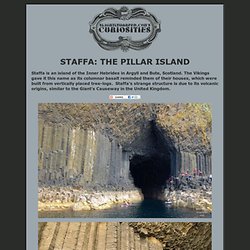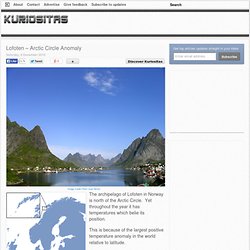

Staffa: The Pillar Island. Staffa is an island of the Inner Hebrides in Argyll and Bute, Scotland.

The Vikings gave it this name as its columnar basalt reminded them of their houses, which were built from vertically placed tree-logs. Staffa's strange structure is due to its volcanic origins, similar to the Giant's Causeway in the United Kingdom. Lofoten – Arctic Circle Anomaly. The archipelago of Lofoten in Norway is north of the Arctic Circle.

Yet throughout the year it has temperatures which belie its position. This is because of the largest positive temperature anomaly in the world relative to latitude. It makes Lofoten an unexpected delight – its early settlers must have thought they had stumbled across an arctic paradise. Prepare to have your breath taken away. What they found there was a sea teeming with life and the largest deep water coral reef in the word. The settlers gave one of the islands (now known as Vestvågøya) the name Lofoten which is Norse for the foot of the lynx. The first settlers must have arrived here centuries before but the archipelago, because of its climate, has been the center of huge cod fisheries for over a millennia. People were drawn to the area mostly because of the sea life. As time went on Lofoten became the name for the whole chain of islands.
The place is so far north that here you can experience the midnight sun. This Dynamic Planet. Most Fascinating Geological Wonders On Earth. Mar 08, 2011 / Category : Misc / 37 Comments This planet we live on offers us beauty beyond words.

Every country has its own special region that takes your breath away with the magnificence of it. Here we can see some places that are a geological wonder that you may know about already, or maybe not? Antelope Canyon, Arizona, USA Antelope Canyon is one of the world's most beautiful canyons. Pamukkale, Turkey These stunning terraces of water are found in Pamukkale Turkey and were shaped from a substance called travertine, which forms from the build-up of sediments of calcium carbonate deposited in water from hot springs. The Wave, Arizona, USA This incredible formation of sandstone rock is stunning in its colors. Moeraki Boulders, New Zealand The Moeraki Boulders are amazing boulders found on the New Zealand coast. Bungle Bungles, Australia Bungle Bungles are found in the the Purnululu National Park in Western Australia, also a World Heritage Site.
Fantasy Cave, Bermuda Wave Rock, Australia. Novel Technique Reveals How Glaciers Sculpted Their Valleys. Thermochronometry allows historical reconstruction of landform evolution during Pleistocene The beautiful and distinctive U-shaped glacial valleys typical of alpine areas from Alaska to New Zealand have fascinated and frustrated geologists for centuries.

While it seems obvious that glaciers scoured the bedrock for millions of years, what the landscape looked like before glaciers appeared, and how the glaciers changed that landscape over time, have remained a mystery. The glaciers erased all the evidence. Now, University of California, Berkeley, and Berkeley Geochronology Center (BGC) scientists have employed a clever technique to reconstruct the landform history of a 300-square-mile area of Fiordland in New Zealand, from the early Pleistocene some 2.5 million years ago, when the world cooled and glaciers formed, through today’s warmer interglacial period. “The first question we asked was, how much of the current landscape and relief is a result of glacial erosion?” On the Net: